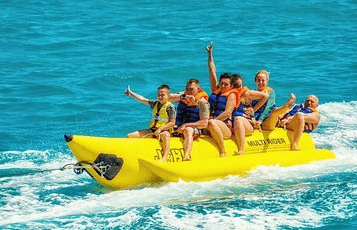Discover the crucial factor that determines if your boat speed is safe

Boating is an exhilarating experience that provides a sense of freedom and adventure. However, it comes with its own set of risks and challenges. One of the most critical aspects of boating safety is determining the appropriate speed for your boat.
Speed not only affects the safety of those on board but also impacts other boats, wildlife, and the environment. Various factors contribute to deciding the safe speed for your boat, including:
- Water conditions
- Boat size and type
- Navigation and obstacles
- Passengers and cargo
- Local laws and regulations
Understanding these factors can help you navigate through any water body with confidence while ensuring the safety of everyone onboard.
In this article, we will explore each factor in detail to provide you with comprehensive insights into how to determine a safe speed for your boat.
Water Conditions
Boaters must always pay attention to the weather, wind, and currents when determining a safe speed for their vessel. These elements can significantly impact water conditions and affect boating speeds.
Understanding how different water conditions, such as choppy waves or strong currents, can affect your boat’s performance is critical in ensuring a safe and enjoyable boating experience.
Therefore, it is essential to be aware of these factors before setting sail to avoid potential hazards that may arise from unfavorable water conditions.
Importance of Paying Attention to Weather, Wind, and Currents
Understanding the influence of weather, wind, and currents is crucial for determining a safe speed while navigating on water. Checking forecasts and understanding tides are two important aspects of this process.
Weather conditions can have a significant impact on boat safety, as high winds and waves can make it difficult to maintain control and stability. Similarly, strong currents can cause boats to drift off course or capsize in extreme cases.
It is essential to pay close attention to these factors before embarking on any journey by boat. By doing so, boaters can ensure that they are well-prepared for any potential hazards that may arise along the way.
Ultimately, taking the time to understand how weather, wind, and currents affect boat safety is an essential step towards achieving a fulfilling and enjoyable experience on the water.
How Different Water Conditions Affect Boating Speeds
Water conditions such as choppy waves and strong currents can significantly impact the ability of a vessel to maintain a consistent speed while navigating on water.
The effects of waves can vary depending on their size, frequency, and direction.
High winds can create large waves that make it difficult for boats to maintain control and stability.
Visibility also plays an important role in determining safe boating speeds.
Poor visibility caused by fog or rain makes it difficult to see other vessels and obstacles in the water, which requires slower speeds for safety reasons.
Additionally, precautions must be taken when boating in adverse conditions such as storms or heavy currents.
It is essential to have proper equipment and knowledge of how to navigate safely in these situations.
Overall, understanding how different water conditions affect boating speeds is crucial for ensuring a safe and enjoyable experience on the water.
Boat Size and Type
The dimensions and design of a vessel are key determinants in establishing the appropriate speed for safe navigation. Boat weight, engine power, hull design, and load capacity all play significant roles in determining the maximum speed at which a boat can safely operate.
A larger boat with a heavier weight will require more power to move through the water and may have limitations on its speed due to its size and shape. The type of hull design will also affect the boat’s performance as some designs are better suited for higher speeds while others are more stable at lower speeds.
Load capacity is another factor that needs to be considered as overloading a boat can reduce its stability and increase the risk of capsizing or sinking. It is important for boaters to understand these factors when determining their vessel’s safe operating speed to ensure a fun yet secure boating experience.
Navigation and Obstacles
The safe operation of a boat is dependent upon the ability of the operator to navigate safely and avoid obstacles. It is crucial for boaters to be aware of their surroundings, particularly when operating at high speeds.
Navigation hazards such as shallow waters, rocks, and other obstructions pose significant risks that can lead to accidents and injuries. Therefore, it is essential for boaters to have a good understanding of navigation rules and techniques in order to operate their vessel safely.
Importance of Knowing Your Surroundings
Familiarizing oneself with the surrounding environment is crucial in ensuring safe navigation and avoiding potential hazards while boating. The importance of situational awareness cannot be overstated, as a lack of it can lead to disastrous consequences.
It is essential to know the waterway, including its depth, currents, and tides. Avoiding distractions is equally important since they can divert attention from critical information and increase the risk of accidents.
Other factors that determine whether your speed is safe for your boat include weather conditions like wind speed and direction, visibility range, and the presence of other vessels or obstacles in the vicinity.
In summary, having an understanding of your surroundings before setting sail can help you avoid danger and make informed decisions that will ensure a safe journey on the waterways.
How Navigation and Obstacles Affect Safe Boating Speeds
Acquiring knowledge of the waterway’s navigation and potential obstacles is crucial in determining a safe boating speed. Navigation plays a critical role in ensuring that the boat stays on course and avoids any hazards along the way.
Obstacles such as rocks, sandbars, or buoys can cause serious damage to both the boat and passengers if they are not navigated around safely. Additionally, distractions like waves or other boats can also impact a vessel’s speed and safety.
Experience is equally important as it allows boaters to anticipate potential hazards and adapt their speed accordingly. Therefore, when navigating through unfamiliar waters, it is essential to pay close attention to one’s surroundings, maintain a slow and steady pace until familiar with the area, and listen carefully to any warnings from local authorities or experienced boaters.
Passengers and Cargo
Passengers and cargo can significantly impact the safe speed of a boat, as they affect the vessel’s stability and maneuverability on the water.
The weight distribution of passengers and cargo needs to be considered when determining a safe speed for a boat.
Overloading a vessel with too much weight can cause it to become unstable, making it more difficult to control and increasing the risk of capsizing.
Passenger capacity is also an important factor to consider, as exceeding the number of recommended passengers can have similar effects on a boat’s stability.
It is important to keep in mind that even if it seems like there is enough space for additional passengers or cargo, exceeding the recommended limits can compromise safety when operating at high speeds on open water.
Proper planning and adherence to these guidelines will ensure that you maintain control over your vessel while enjoying your time out on the water.
Local Laws and Regulations
It is important for boaters to have knowledge of local laws and regulations pertaining to boating. Understanding these laws can affect the safe speed at which a boat can operate on the water.
As previously discussed, factors such as weather conditions, visibility, passenger and cargo weight can also influence safe speeds. In addition to these factors, implementing safety tips for boating at safe speeds can help ensure a safe and enjoyable boating experience.
Importance of Knowing Local Boating Laws and Regulations
Familiarizing oneself with local boating laws and regulations is crucial in determining the safe speed for a boat, as these laws often set limits based on factors such as waterway conditions, visibility, and other potential hazards.
Understanding penalties for violating these laws and enrolling in boating education programs can also improve one’s knowledge of safe speeds.
Boaters must be aware of restrictions such as no-wake zones or posted speed limits to avoid collisions with other vessels or objects in the water.
Additionally, knowing about specific rules regarding alcohol consumption while operating a boat can prevent dangerous situations.
By adhering to local regulations and understanding their importance, boaters can ensure that they are operating their vessel at a safe speed and avoiding any unnecessary risks on the water.
How Laws and Regulations Affect Safe Boating Speeds
Understanding local boating laws and regulations is essential for determining the appropriate speed of a vessel, as these regulations take into account various environmental factors and potential hazards that can affect safe navigation.
The importance of education cannot be overstated when it comes to safe boating speeds, as it allows individuals to have a clear understanding of what is expected of them in terms of complying with local laws and regulations.
Additionally, enforcement plays a significant role in ensuring that boat operators adhere to the set speed limits, thereby reducing the risk of accidents on waterways.
By following these laws and regulations, boaters can navigate safely through different environments while maintaining an enjoyable experience on the water.
Thus, learning about how laws and regulations affect safe boating speeds is crucial for every boat operator who values their safety and that of other water users.
Recap of Factors That Determine Safe Boating Speeds
Acquiring knowledge about the factors affecting safe boating speeds is like assembling a puzzle, where each piece represents an essential factor that must be considered for a successful outcome.
Some of these factors include the type and size of your boat, weather conditions, sea state, water depth, and visibility.
Understanding your boat’s capabilities is also crucial in determining a safe speed to navigate through waterways.
It is important to remain vigilant and aware of any potential hazards that may arise while operating your vessel at high speeds.
By considering all of these elements carefully, you can ensure that you are adhering to responsible boating practices and keeping yourself and others safe on the water.
Safety Tips for Boating at Safe Speeds
To ensure a safe boating experience, it is important to follow these safety tips when navigating at appropriate speeds.
One key factor in determining a safe speed for your boat is the importance of experience. Knowing how to properly control and maneuver your vessel can greatly reduce the risk of accidents on the water.
Additionally, proper maintenance of your boat is crucial in ensuring that it operates safely and efficiently. Regular inspections, repairs, and upgrades can prevent mechanical failures that could lead to dangerous situations while out on the water.
By following these safety tips and taking necessary precautions, boaters can enjoy their freedom on the water while minimizing risks and ensuring a safe journey.
Conclusion
When it comes to boating, there are several factors that must be taken into consideration to determine a safe speed. These include water conditions, boat size and type, navigation and obstacles, passengers and cargo, as well as local laws and regulations. Each of these factors plays a significant role in ensuring the safety of both the operator and passengers.
Water conditions such as wind, waves, and currents can greatly affect the ability to control a vessel at high speeds. Additionally, boat size and type determine its maneuverability and stability in different water conditions. Navigation and obstacles like rocks or other vessels must also be taken into account when determining a safe speed.
The number of passengers onboard along with their weight distribution can impact the vessel’s stability as well. Finally, following local laws and regulations regarding speed limits is crucial for the safety of everyone on the water.
In essence, determining a safe speed for your boat requires careful consideration of multiple variables that work together to ensure safe operation on the water. Just like navigating through life’s challenges requires taking into account various factors that shape our experiences – from personal relationships to societal norms – understanding how different elements interact with each other is key to making informed decisions that lead us towards our goals safely and effectively.
By taking note of these considerations when operating a vessel on open waters, boaters can ensure not only their own safety but also those around them while enjoying all that nature has to offer.




